by Elyn Aviva
Welcome to Ynys-witrin, the Island of Glass, AKA “Glasto,” thriving spiritual theme park for the New Age, neo-pagans, witches, traditional Catholics, Anglicans, Buddhists, Hindus, Methodist church ladies, sound healers, shamanic journey-ers, light therapists, Arthurian aficionados, Isle of Avalon pilgrims, holy-well-water visitors, Grail seekers, and recovering addicts. If that makes your head buzz, it should. And that ain’t the half of it.
 Glastonbury Park 2013. Photo by jaswooduk.
Glastonbury Park 2013. Photo by jaswooduk.
We had decided to spend a month in Glastonbury. It had seemed like a good idea at the time—which should have been a warning signal. A month in Glastonbury? A town where every time we had visited for a few days we shook our heads and said, “NOT a place to stay for very long! Too intense, too ungrounded…” But somehow, in a moment of inspired weakness, it seemed like a good idea. Get away from our apartment in Girona (Catalonia, Spain) where we couldn’t seem to get away from work. Rest and relax in a rural Somerset town where we could go for gentle walks up to the scenic tower on top of the 500-foot high, dragon-backed Tor hill, or visit the lush and lovely Chalice Well Gardens, or stroll through the extensive grounds of the ruined but still evocative Glastonbury Abbey.
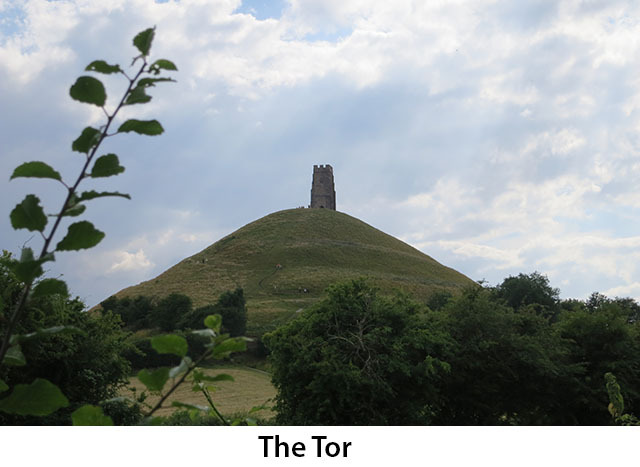
We rented a self-catering (British for “accommodation with kitchen”) cottage a short block from the main crossroads of the town. The walled garden enclosing the group of holiday homes was tranquil, filled with well-tended potted plants, ornamental trees, and a fountain. The fountain was a bronze statue of a naked woman holding an upturned vase over her head. Water dribbled from the vessel, flowed down her breasts, and gurgled into a small pool stocked with flickering carp. It was oddly soothing.
The first afternoon, we sat at the shaded picnic table and met our next-door neighbor, a “gifted psychic and tarot card reader” visiting from Canada. Her sessions were advertised in one of the numerous esoteric gift shops on the main street. Four other guests were on a sacred-sites tour led by a noted California medium. They were hoping to experience new and thrilling revelations about Arthur and Guinevere, whose bodies (now long lost) had supposedly been found buried in the Abbey grounds in the year 1191. A young Italian woman with a silk-flower garland in her hair had come for the Glastonbury Goddess Festival, an annual event dedicated to (you guessed it) the Goddess in her many manifestations.
We excused ourselves from the convivial, wine-fueled conversations and strolled up the High Street toward St John’s Church, passing tiny and not-so-small shops specializing in gemstone jewelry; used books; esoteric paraphernalia; candles and incense; supplies for pagan rituals and magical acts of all sorts; charity re-sale; vegetarian meals; and healing therapies and shamanic journeys and training as priest or priestess of various one-off denominations.
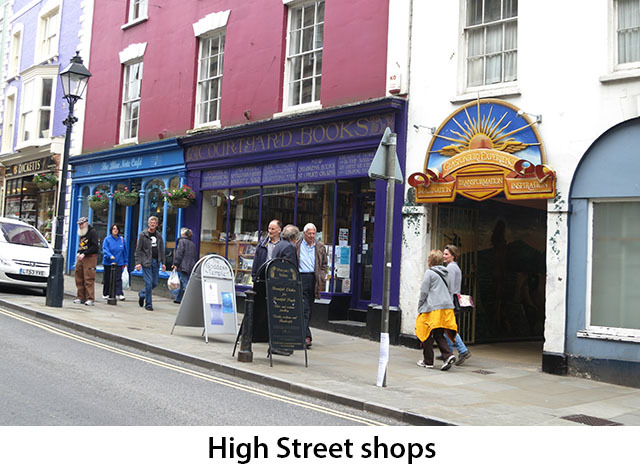
The competition for attention was overwhelming—as was the almost palpable sense of hunger. People come to Glasto hungry for meaning, for healing, for understanding; hungry for information about the future, the past, the unknown and unknowable. And then there are the merchants, healers, psychics, seers, gurus, and teachers, hungry to have clients, make a living, make a name.
It was a bit much. We headed to the Abbey grounds for shelter from the psychic din. A ruin of its former grandeur, Glastonbury Abbey’s fame rests on its association with Joseph of Arimathea and Jesus, who are purported to have visited the spot in AD something or other, perhaps when Jesus was a youth and traveled to England with his metal-merchant uncle. This was during the time when Glastonbury was surrounded by water when the sea came rolling in and the marshy land sank beneath the surface. Isle of Avalon? Maybe so….
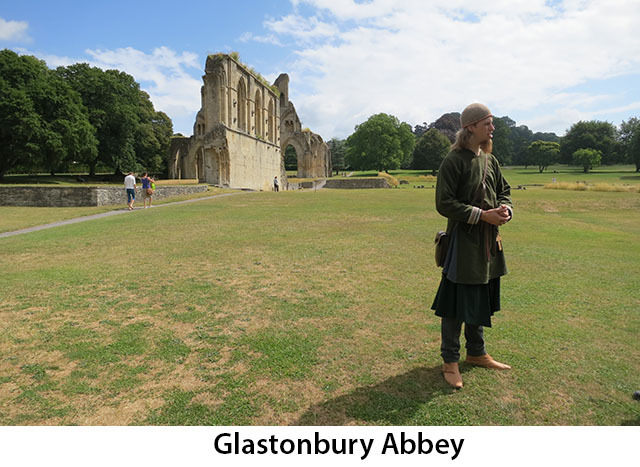
Joseph supposedly left behind a flowering staff that grew into the sacred Glastonbury Thorn, which blooms at Christmastime. One distant descendent of that original tree grows beside the Abbey walls, and a spray is still presented to the ruling English monarch on Christmas Day.
Promotional literature asserts that Joseph and Jesus built a church on what is now the Abbey grounds—a church that later became a little chapel, and later still, a powerful medieval abbey, the most powerful in England. Never mind that Jesus and Joseph were Jewish and not very likely to have built a church….
At any rate, the Abbey became exceedingly wealthy, and when it needed resources to recover from a disastrous fire, the tombs of Arthur and Guinevere were conveniently discovered in the Abbey grounds—and pilgrimages began anew. Until 1536, when the Abbey fell victim to King Henry VIII’s desire for divorce and need for money. Henry VIII declared himself head of the Church of England and took over by force the monasteries. Including Glastonbury Abbey. In 1539, the aged ailing abbot, Richard Whiting, and two monks, John Thorne and Roger James, were dragged up to the top of the Tor and hanged, beheaded, drawn and quartered. A lesson to any who might want to challenge the king.
Today the evocative Abbey ruins are populated with living-history interpreters dressed in period garb, a tent with raptors on display, a tiny café serving ice cream and snacks, outdoor summer theater troupes, and numerous tour groups and dowsers. It’s a little dicey to be dowsing in the Abbey grounds, however; you have to ask permission at the ticket office. The clerk explained to me when I inquired about the “dowsers take warning” sign: “We get people trying to dowse for hidden treasure, and we simply can’t allow that.” I tried to imagine a dowsing warning sign in a similar space in the US but my imagination failed.
The Abbey grounds are impressive—36 acres of parkland—including numerous varieties of trees, a badger warren, a fishpond, and an extensive herb garden. It has plenty of places to get away from the madding crowd, the “majestic pile of the Abbey,” and commune with nature. Which we did. But the Abbey closed at 8 pm and we were once again wandering the streets of Glasto. A man in a flowing black velvet sorcerer’s robe and conical hat strode quickly down the sidewalk.
Another day we rode the blue Tor bus on its circuit from the Abbey parking lot to the Somerset Rural Life Museum (free admission) to the Chalice Well Gardens and around to the back of the Tor. High above us was the ruined tower of St Michael’s church, all that remained after a powerful earthquake struck the hill on 9/11/1275. Rumor says the Tor is a hollow hill and the Lord of the Underworld lives within. Or maybe that’s where Joseph of Arimathea buried the Grail. I get confused….
From the base of the Tor, I saw small figures moving slowly across the top ridge: pilgrims to the tower, hikers eager for the view, standing (unknowingly) on the spot where Abbot Whiting and his two companions were hanged and quartered. Slowly we followed the steep trail up the side of the hill, forgoing a much more complex and barely visible path that loops back and forth around the Tor.
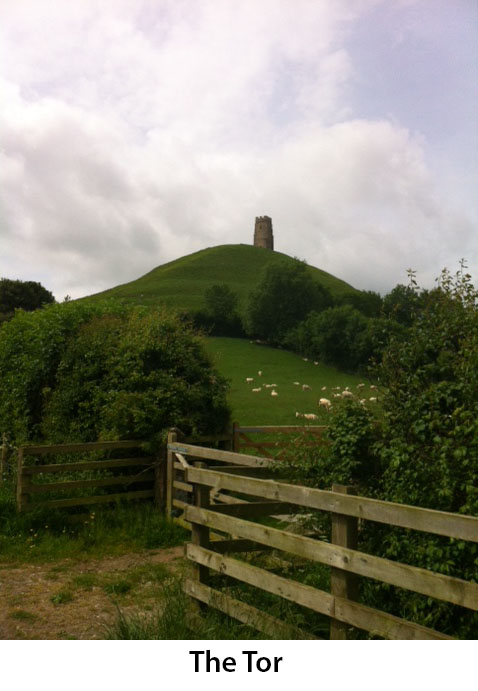
Some think this path is a 3-D labyrinth inscribed upon its green slopes in some unknown time. Another mystery of Glastonbury. Random terracing or intentional pattern? A question of faith, or maybe of imagination. A barefoot man dressed in white pants and shirt trod carefully across our path and continued on the labyrinth trail, a Xeroxed graphic of the hill clutched in his hands, his sandals looped around his neck.
Down the other side of the Tor and across the street, we paid our entrance fee and entered another iconic place: the Chalice Well Gardens, a gorgeous exuberant mass of yew trees and bushes and flowers of all sorts, arranged alongside a rust-red flowing stream that issues out of the Chalice Well, its waters stained from dissolved iron. This is the Red Well, its wrought-iron well cover designed in the shape of a vesica pisces and, legend says, related to the Grail. Or maybe that was found somewhere else. There’s a small glass bowl that someone claimed was the Holy Grail, found in a fountain named after St Brigit, who (legend says) settled briefly in Glastonbury. When she returned home to Ireland, she left behind a few items and her name, transformed into “Beckery.”
Groups of tourists descended like buzzing bees on the gardens and we escaped again, still seeking quiet. We strolled up Wearyall Hill, so-named because Joseph of Arimathea—yes, him again!—had supposedly landed there with a host of 12 (please note the number) companions, strode to the top, and rested, wearily. Here he planted his staff, which grew into the Holy Thorn tree. Sadly, in 2010 someone desecrated the descendent of the original tree and sawed off its branches. And someone destroyed the replanted clone in 2012. A landowners’ feud? Or perhaps a battle between Good and Evil, centered on a sacred and symbolic tree.
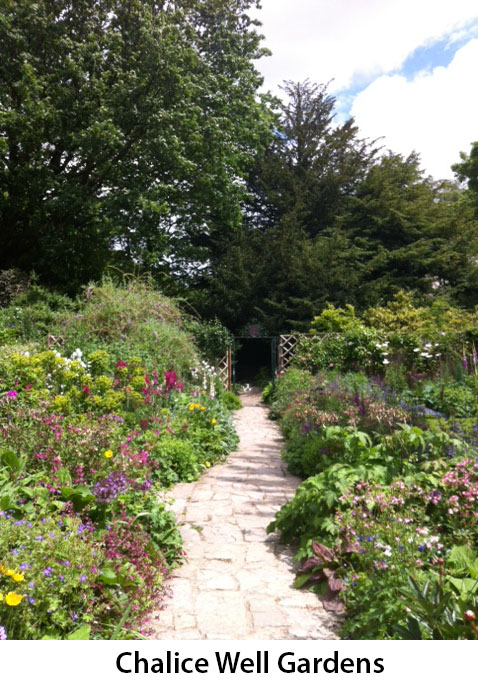
In Glasto, all is mystery or at least mysterious. Legends abound. Truth is malleable. Motives are many. Cruelty abounds, along with grace. Exhausted from so much intensity and confusion, we fled. We fled to Penzance, Cornwall, famous for its pirates, driven by our new Glastonbury friend, a retired porno star. But that’s another story.
Elyn Aviva is a transformational traveler, writer, and fiber artist who lives in Girona, Spain. Her blog is www.powerfulplaces.info. She is co-author with her husband, Gary White, of “Powerful Places Guidebooks.” To learn more about her publications, go to www.powerfulplaces.com and www.pilgrimsprocess.com. To learn about Elyn’s fiber art, go to www.fiberalchemy.com.
Photo credits: lead photograph by jaswooduk via Flickr CCL; all others by Gary White.



